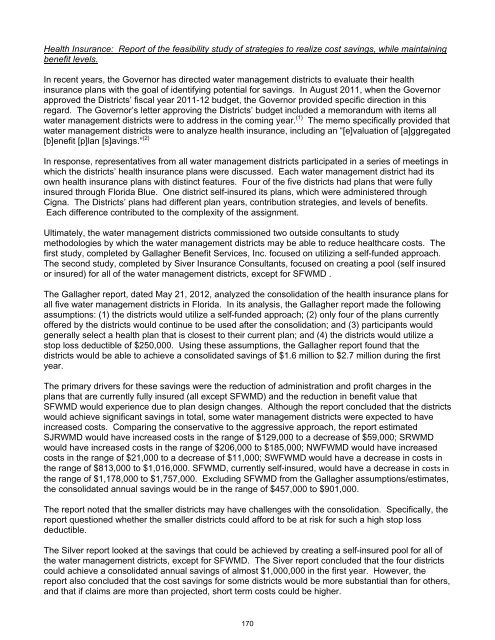Standard Format Tentative Budget Submission - Southwest Florida ...
Standard Format Tentative Budget Submission - Southwest Florida ...
Standard Format Tentative Budget Submission - Southwest Florida ...
Create successful ePaper yourself
Turn your PDF publications into a flip-book with our unique Google optimized e-Paper software.
Health Insurance: Report of the feasibility study of strategies to realize cost savings, while maintaining<br />
benefit levels.<br />
In recent years, the Governor has directed water management districts to evaluate their health<br />
insurance plans with the goal of identifying potential for savings. In August 2011, when the Governor<br />
approved the Districts’ fiscal year 2011-12 budget, the Governor provided specific direction in this<br />
regard. The Governor’s letter approving the Districts’ budget included a memorandum with items all<br />
water management districts were to address in the coming year. (1) The memo specifically provided that<br />
water management districts were to analyze health insurance, including an “[e]valuation of [a]ggregated<br />
[b]enefit [p]lan [s]avings.” (2)<br />
In response, representatives from all water management districts participated in a series of meetings in<br />
which the districts’ health insurance plans were discussed. Each water management district had its<br />
own health insurance plans with distinct features. Four of the five districts had plans that were fully<br />
insured through <strong>Florida</strong> Blue. One district self-insured its plans, which were administered through<br />
Cigna. The Districts’ plans had different plan years, contribution strategies, and levels of benefits.<br />
Each difference contributed to the complexity of the assignment.<br />
Ultimately, the water management districts commissioned two outside consultants to study<br />
methodologies by which the water management districts may be able to reduce healthcare costs. The<br />
first study, completed by Gallagher Benefit Services, Inc. focused on utilizing a self-funded approach.<br />
The second study, completed by Siver Insurance Consultants, focused on creating a pool (self insured<br />
or insured) for all of the water management districts, except for SFWMD .<br />
The Gallagher report, dated May 21, 2012, analyzed the consolidation of the health insurance plans for<br />
all five water management districts in <strong>Florida</strong>. In its analysis, the Gallagher report made the following<br />
assumptions: (1) the districts would utilize a self-funded approach; (2) only four of the plans currently<br />
offered by the districts would continue to be used after the consolidation; and (3) participants would<br />
generally select a health plan that is closest to their current plan; and (4) the districts would utilize a<br />
stop loss deductible of $250,000. Using these assumptions, the Gallagher report found that the<br />
districts would be able to achieve a consolidated savings of $1.6 million to $2.7 million during the first<br />
year.<br />
The primary drivers for these savings were the reduction of administration and profit charges in the<br />
plans that are currently fully insured (all except SFWMD) and the reduction in benefit value that<br />
SFWMD would experience due to plan design changes. Although the report concluded that the districts<br />
would achieve significant savings in total, some water management districts were expected to have<br />
increased costs. Comparing the conservative to the aggressive approach, the report estimated<br />
SJRWMD would have increased costs in the range of $129,000 to a decrease of $59,000; SRWMD<br />
would have increased costs in the range of $206,000 to $185,000; NWFWMD would have increased<br />
costs in the range of $21,000 to a decrease of $11,000; SWFWMD would have a decrease in costs in<br />
the range of $813,000 to $1,016,000. SFWMD, currently self-insured, would have a decrease in costs in<br />
the range of $1,178,000 to $1,757,000. Excluding SFWMD from the Gallagher assumptions/estimates,<br />
the consolidated annual savings would be in the range of $457,000 to $901,000.<br />
The report noted that the smaller districts may have challenges with the consolidation. Specifically, the<br />
report questioned whether the smaller districts could afford to be at risk for such a high stop loss<br />
deductible.<br />
The Silver report looked at the savings that could be achieved by creating a self-insured pool for all of<br />
the water management districts, except for SFWMD. The Siver report concluded that the four districts<br />
could achieve a consolidated annual savings of almost $1,000,000 in the first year. However, the<br />
report also concluded that the cost savings for some districts would be more substantial than for others,<br />
and that if claims are more than projected, short term costs could be higher.<br />
170

















